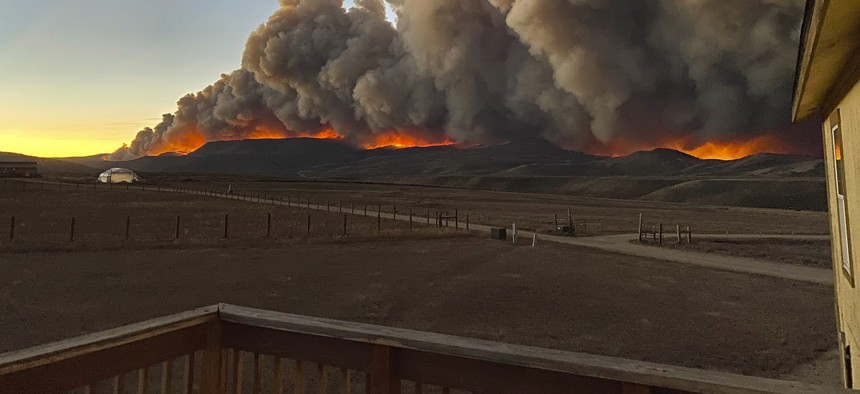Fire Official Urges Governors to Be Proactive on Hardening Homes Against Wildfire

A resident took this photo from the deck of her home north of Granby, Colo., just before sunset on Wednesday, Oct. 21, 2020 as a wildfire burned in the distance. Jessy Ellenberger via AP
Failing to do so, the official said, means “we're just building tomorrow’s problems.”
States and localities need to be taking a hard look at the building standards for houses located in wildfire-prone areas, a leading fire official told governors from western states this week.
Kim Zagaris, wildfire policy and technology advisor for the Western Fire Chiefs Association, emphasized the importance of both updating building codes to make newly built homes more resilient to fire and also upgrading existing structures so they’re less likely to burn.
“The building code issue is always a tough one to deal with … Between developers and the real estate market, nobody wants to add additional cost on,” said Zagaris, previously the state fire and rescue chief for the California Governor’s Office of Emergency Services.
“If we don't add the cost,” he went on to say, “if we don’t find a way to build better homes and make them more fireproof, then we're just building tomorrow’s problems.”
Speaking at a Western Governors’ Association roundtable discussion on wildfire issues, Zagaris said that when the 2018 Camp Fire devastated the town of Paradise, California, there were about 350 single family homes there that were built to newer building code standards. About half of those houses survived the blaze, he said.
By comparison, only about 18% of the roughly 12,000 homes built to earlier standards escaped severe damage.
Zagaris explained that the newer building rules, which state lawmakers approved in 2008, put in place requirements for fire resistant roofs and siding, as well as other safeguards intended to prevent burning embers from getting into houses, through vents for instance, and setting the structures aflame.
“That was landmark legislation,” Zagaris said.
He also noted “ember intrusion,” as opposed to the flames of a wildfire consuming a house entirely, is a key risk to homes threatened by fire.
Zagaris also recommended that states look for new options to work with other levels of government and insurers to find ways to incentivize, and to make it more cost effective for, homeowners to make upgrades that will help to fireproof their homes.
Construction standards are just one issue that government leaders are considering after western states have dealt with repeated catastrophic wildfires in recent years, including this summer when especially destructive fires hit populated parts of Oregon and as large swaths of the west coast for days experienced smoke-filled skies.
There’s also increasingly broad recognition among state officials and others that additional land management efforts—including setting more “prescribed” or controlled fires and letting lower-risk wildfires burn—need to be taken.
Wyoming Gov. Mark Gordon, a Republican, noted during the roundtable that wildfires are a natural part of western ecosystems, but also acknowledged that they’ve in recent years often been more intense and frequent. Those trends, he said, are in many cases exacerbated by the “ever-increasing creep of urban and suburban infrastructure” into outlying areas.
Gordon pointed out that, as this year’s outbreak of the highly contagious coronavirus has left many people working remotely and seeking to keep distance from others, there are signs more people are moving into open parts of states like Wyoming, Montana and Idaho.
“This is an issue that's going to become even more complicated as we go forward,” he said. The challenges that property and communities in the so-called “urban-wildland interface” pose for land managers, Gordon added, are “really remarkable. It stresses resources.”
Bill Lucia is a senior reporter for Route Fifty and is based in Olympia, Washington.
NEXT STORY: ‘Trigger Laws’ in Some States Would Ban Abortion Immediately If Roe is Overturned






